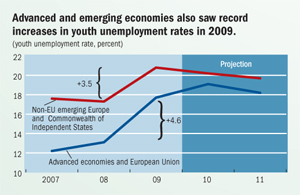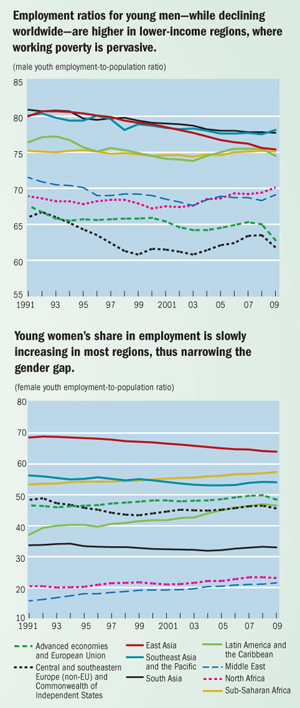Picture This
Youth for Hire
Finance & Development, December 2010, Vol. 47, No. 4
The global economic crisis has led to the highest youth unemployment rates ever
YOUNG PEOPLE have been particularly vulnerable to unemployment during the global recession and the accompanying shrinking job market. In 2009, an estimated 81 million young people ages 15 to 24 were unemployed around the world—a record—and the number is expected to continue to increase in 2010, according to the International Labor Organization (ILO). The youth unemployment rate increased from 12.1 percent in 2008 to 13.0 percent in 2009—the largest-ever annual increase in the global rate. In 2009 alone, 6.7 million youths joined the ranks of the unemployed. This compares with an average annual increase of 191,000 in the 10 years before the crisis (1997 to 2007).

Young people have long been disadvantaged when it comes to finding work, for many reasons: they have less work experience; they have less knowledge about how and where to look for work; and they have fewer job-search contacts. The result is a global youth unemployment rate nearly three times higher than the adult unemployment rate—a ratio that has not changed significantly over time.
Youths in advanced regions most vulnerable

In advanced and some emerging economies—where the youth unemployment rates are much higher than the global rate—the crisis affects young people mainly in terms of rising unemployment and the social hazards associated with long-term job searches, discouragement, and prolonged inactivity. Many young people are taking any part-time employment they can find or feel trapped in a less than satisfactory job they fear leaving lest they fail to find another. Alternatively, some go back to school for another degree and hope for better economic times when they try to reenter the labor market. Governments in these regions are struggling to prevent a situation in which young people, having lost all hope of being able to work for a decent living, give up and settle for long-term dependence on state income support.
Working but still poor in developing regions

In contrast, in developing economies—where 90 percent of the world’s young people live and where social protection frameworks do not provide unemployment benefits that support job search—the unemployment statistics seem less dire because most youths have no choice but to work. The lowest-income regions—specifically sub-Saharan Africa, southeast Asia and the Pacific, and south Asia—continue to show the highest employment-to-population ratios, a reflection of the need to contribute to household income. Young men and women (in countries where the social norms accommodate women’s participation in the job market) typically work in the informal economy, often in self-employed or occasional wage activities, such as seasonal farm work.
These are the young people trapped in what the ILO calls “decent work deficits”—those who work long hours, often under very difficult conditions, but still live in poverty. The ILO estimates that 152 million young people were living on less than $1.25 a day in 2008. This number is down from 234 million in 1998 but still represents a remarkable 28 percent of all young workers in the world. The majority of the young working poor lack even a primary-level education and are employed in the agricultural sector.
Better education needed
There is no one-size-fits-all solution to raising youth employment prospects. Continuing efforts are clearly needed in improved access to and quality of education to boost young people’s chance for decent employment. Enrollment in education is increasing around the world and is reflected in part in the declining employment ratios of young men. Young women too are making gains in education, but with a lag. At the same time, there are some improvements in the gender gap as attitudes against the economic participation of young women slowly begin to change. More generally, additional means of improving decent work prospects for all young citizens include policies and national programs that encourage businesses to hire young people, promote youth entrepreneurship, and facilitate access to financial services. ■
Prepared by Sara Elder, an Economist at the International Labor Organization. Text and charts are based on Global Employment Trends for Youth (August), published by the ILO in 2010, and underlying data from the ILO’s Trends Econometric Models (April 2010). The main report is available at www.ilo.org/youth, and the underlying data at www.ilo.org/trends


